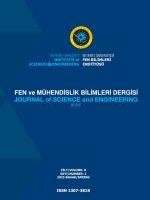TEDARİK ZİNCİRİ DİRENCİLİĞİNİ ARTIRMAK İÇİN DİJİTALLEŞME OLASILIKLARI VE SINIRLARI
Beklenmeyen herhangi bir durumun meydana gelmesi durumunda, bir tedarik zinciri, teslim edilememe veya teslimatta büyük gecikmeler gibi çok çeşitli olumsuz sonuçlarla büyük ölçüde etkilenebilir. Bu nedenle, her tedarik zinciri ve bunlara dahil olan şirketler için bu olumsuz sonuçların azaltılması önemlidir. Bu bağlamda, Tedarik Zinciri Esnekliği (SCR) terimi, bir tedarik zincirinin kesintilere yanıt verme ve kesintilerden kurtulma konusundaki uyarlanabilirlik düzeyini ifade eder. Operasyonel sürekliliğin sürdürülmesi hızlı bir şekilde mümkünse, yüksek bir SCR verilir. Beklenmedik kesintilere bir örnek olarak, COVID19 krizi, küresel tedarik zincirlerinin işlevselliği üzerinde büyük etkiler gösterdi. Temelde Endüstri 4.0 olarak bilinen endüstriyel Dijitalleşmenin yaklaşan teknolojileri, SCR'yi artırmak için fırsatlar sunuyor. Bu yazıda, öncelikle küresel tedarik zincirleri üzerindeki COVID19 etkisini göstermek ve bu nedenle genel olarak SCR'yi artırma ihtiyacını kanıtlamak için farklı anketlere kısa bir genel bakış verilmektedir. İkinci olarak, özellikle Dijitalleşmenin SCR'yi artırmaya nasıl yardımcı olabileceğine dair bir fikir verilmektedir. Özellikle tüm tedarik zinciri ortakları için veri tabanının iyileştirilmesi, Yapay Zeka kullanımı da dahil olmak üzere daha hızlı ve daha kesin karar verme süreçleri anlatılmaktadır. Son olarak, SCR'yi artırmak için Dijitalleşmeyi kullanmanın olumlu şansları ve başlıca zorlukları ele alınmaktadır.
Anahtar Kelimeler:
Tedarik Zinciri Yönetimi, Dijitalleşme, Endüstri 4.0, COVID19, Dayanıklılık, Supply Chain Management, Digitalization, Industry 4.0, Resilience
POSSIBILITIES AND LIMITS OF DIGITALIZATION TO INCREASE SUPPLY CHAIN RESILIENCE
In case any unexpected circumstances occur, a supply chain may be heavily influenced with a wide range of negative consequences such as inability to deliver or large delays in delivery. Therefore, it is important for every supply chain and the companies that are involved in them to reduce these negative outcomes. In this context, the term Supply Chain Resilience (SCR) stands for the level of adaptability of a supply chain to respond to and recover from disruptions. A high SCR is given if re-maintaining operational continuity is quickly possible. As an example of unexpected disruptions, the COVID19-crisis showed major impacts on the functionality of global supply chains. The upcoming technologies of industrial Digitalization, mainly known as Industry 4.0, provide opportunities to increase SCR. In this paper, first a brief overview of different surveys is given to show the COVID19-impact on global supply chains and therefore prove the need to generally increase SCR. Second, an insight of how especially Digitalization may help to increase SCR is provided. Especially improving the data base for all supply chain partners, faster and more precise decision-making processes, including the use of Artificial Intelligence, are described. Finally, positive chances and major challenges of using Digitalization to increase SCR are addressed.
Keywords:
Supply Chain Management, Digitalization, Industry 4.0, Resilience,
___
- Belhadi, A., Kamble, S., Jabbour, C.J.C., Gunasekaran, A., Ndubisi, N.O. and Venkatesh, M. (2021). Manufacturing and service supply chain resilience to the COVID-19 outbreak: Lessons learned from the automobile and airline industries. Technological Forecasting and Social Change, 163. https://doi.org/10.1016/j.techfore.2020.120447.
- Black, S. and Glaser-Segura, D. (2020). Supply chain resilience in a pandemic: The need for revised contingency planning. Management Dynamics in the Knowledge Economy, 8(4), 325-343. https://doi.org/10.2478/mdke-2020-0021.
- Capgemini (2021). The wake-up call: Building supply chain resilience in consumer products and retail for a post-COVID world. https://www.capgemini.com/de-de/wp-content/uploads/sites/5/2021/03/Supply-Chain-in-CPR_2021-03-10_Web.pdf.
- Das, D., Datta, A., Kumar, P., Kazancoglu, Y. and Ram, M. (2021). Building supply chain resilience in the era of COVID‑19: An AHP‑DEMATEL approach. Operations Management Research. https://doi.org/10.1007/s12063-021-00200-4.
- Das, D., Datta, A., Kumar, P., Kazancoglu, Y. and Ram, M. (2022). Building supply chain resilience in the era of COVID-19: An AHP-DEMATEL approach. Operations Management Research, 15(1–2), 249–267. https://doi.org/10.1007/s12063-021-00200-4
- Deloitte (2020). Building Supply Chain Resilience beyond COVID-19. file:///C:/Users/marc-/Desktop/deloitte-ch-study-building-supply-chain-resilience-covid-19-2020.pdf.
- Heß, G. and Kleinlein, A.C. (2021). Resilienz im Einkauf - Konzept und Praxisleitfaden zum Management unerwarteter Risiken in der Lieferkette. SpringerGabler.
- Hobbs, J.E. (2021). Food supply chain resilience and the COVID-19 pandemic: What have we learned?. Canadian Journal of Agricultural Economics. 69, 189-196. https://doi.org/10.1111/cjag.12279.
- Ivanov, D. and Das, A. (2020). Coronavirus (COVID-19/SARS-CoV-2) and supply chain resilience: a research note, International Journal on Integrated Supply Management, 13(1), 90-102. https://dx.doi.org/10.1504/IJISM.2020.107780.
- Karger, T. and Seewald, D. (n.d.). Aufbau einer Supply Chain nach COVID-19. https://www.efficioconsulting.com/de/publikationen/insights/aufbau-einer-supply-chain-nach-covid-19/. McKinsey (2020). Resetting supply chains for the next normal. https://www.mckinsey.com/business-functions/operations/our-insights/resetting-supply-chains-for-the-next-normal.
- Miceli, A., Hagen, B., Riccardi, M.P., Sotti, F. and Settembre-Blundo, D. (2021). Thriving, not just surviving in changing times: How sustainability, agility and digitalization intertwine with organizational resilience. Sustainability, 13, 2052. https://doi.org/10.3390/su13042052.
- Nandi, S., Sarkis, J., Hervani, A. and Helms, M. (2020). Do blockchain and circular economy practices improve post COVID-19 supply chains? A resource-based and resource dependence perspective. Industrial Management and Data Systems, 121(2), 333-363. https://doi.org/10.1108/IMDS-09-2020-0560.
- Nandi, S., Sarkis, J., Hervani, A. and Helms, M. (2021). Redesigning supply chains using blockchain-enabled circular economy and COVID-19 experiences. Sustainable Production and Consumption, 27, 10-22. https://doi.org/10.1016/j.spc.2020.10.019.
- Riecke, T. (2021, August 16). Trotz dramatischer Engpässe: Deutsche Firmen halten an Ihren Lieferketten fest. Handelsblatt. https://www.handelsblatt.com/meinung/kolumnen/globale-trends/globale-trends-trotz-dramatischer-engpaesse-deutsche-firmen-halten-an-ihren-lieferketten-fest/27519328.html?ticket=ST-4715831-9kCEhYf0r6oekygYrYne-cas01.example.org.
- Semmann, C. (2020, December 16). Lieferketten nach Corona: Was Unternehmen planen. Deutsche Verkehrszeitung. https://www.dvz.de/dossiers/zukunft-der-lieferketten/detail/news/lieferketten-auf-dem-pruefstand-1.html.
- Shen, Z.M. and Sun, Y. (2021). Strengthening supply chain resilience during COVID-19: A case study of JD.com. Journal of Operations Management. https://doi.org/10.1002/joom.1161.
- Sherman, E. (2020). 94% of the Fortune 1000 are seeing coronavirus supply chain disruptions: Report. https://fortune.com/2020/02/21/fortune-1000-coronavirus-china-supply-chain-impact/.
- Tasnim, Z. (2020). Disruption in global food supply chain (FSCs) due to Covid-19 pandemic and impact of digitalization through block chain technology in FSCs management. European Journal of Business and Management, 12(17), 73-84. https://doi.org/10.7176/EJBM/12-17-08.
- VDMA, IfW (2020). Lieferketten in der Zeit nach Corona. Kurzgutachten im Auftrag der IMPULS Stiftung für den Maschinenbau, den Anlagenbau und die Informationstechnik. https://www.ifw-kiel.de/fileadmin/Dateiverwaltung/IfW-Publications/-ifw/Policy_Papers/2021/Lieferketten_in_der_Zeit_nach_Corona_Endbericht.pdf.
- Weber, M.A. (2021). Nutzung der Digitalisierung zur Produktivitätsverbesserung in industriellen Prozessen unter Berücksichtigung arbeitswissenschaftlicher Anforderungen. Springer.
- ISSN: 1307-3818
- Başlangıç: 2007
- Yayıncı: Beykent Üniversitesi
Sayıdaki Diğer Makaleler
GERÇEK HAYAT AKTARMA PROBLEMİNE TAM ÇÖZÜM
Zehra HAFIZOĞLU GÖKDAĞ, Salih CEBECİ
TERSİNE LOJİSTİKTE DİJİTALLEŞMENİN KRİTİK FAKTÖRLERİ ÜZERİNE BİR ÇALIŞMA
G.nilay YÜCENUR, Sena ÇALIŞKAN, Özge İRTEN, İlker ŞAHİN
Türkiye’deki Akıllı Kargo Dolabı Uygulamaları
TEDARİK ZİNCİRİ DİRENCİLİĞİNİ ARTIRMAK İÇİN DİJİTALLEŞME OLASILIKLARI VE SINIRLARI
